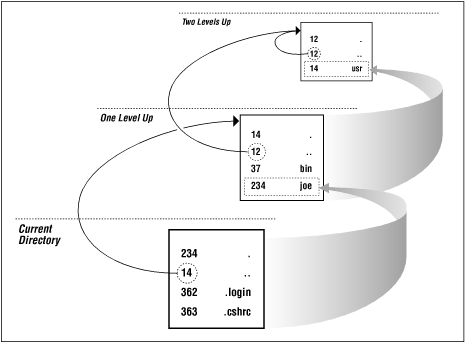
|
Chapter 14 Moving Around in a Hurry |

|
A command like
pwd
inherits the current directory of the process that started it (usually, a shell). It could be started from anywhere. How does
pwd
find out where it is in the filesystem? See
Figure 14.2
for a picture of the current directory
/usr/joe
and its parent directories.
The current directory doesn't contain its own name, so that doesn't help
pwd
. But it has an entry named
.
(dot), which gives the
i-number ofthe directory . (
18.2
)

The current directory has i-number 234. Next,
pwd
asks UNIX to open the parent directory file, the directory one level up, through the relative pathname (
..
). It's looking for the name that goes with i-number 234. Aha; the current directory is named
joe
. So the end of the pathname must be
joe
.
Next step.
pwd
looks at the
.
entry in the directory one level up to get its i-number: 14. Like always, the name of the one-level-up directory is in its parent (
..
, i-number 12). To get its name,
pwd
opens the directory two levels up and looks for i-number 14:
usr
. Now
pwd
has the pathname
usr/joe
.
Same steps: look in the parent, i-number 12. What's its name? Hmmm. The i-number of its parent, 12, is the same as its own-and there's only one directory on the filesystem like this: the root directory. So, pwd adds a slash to the start of the pathname and it's done: /usr/joe .
That's really missing one or two parts: Filesystems can be mounted on other filesystems, or can be mounted across the network from other hosts. So, at each step, pwd also needs to check the device that the current directory is mounted on. If you're curious, see the stat (2) manual page or check a UNIX internals book. Also see the last few paragraphs of article 18.4 for more about the links between directories.
-